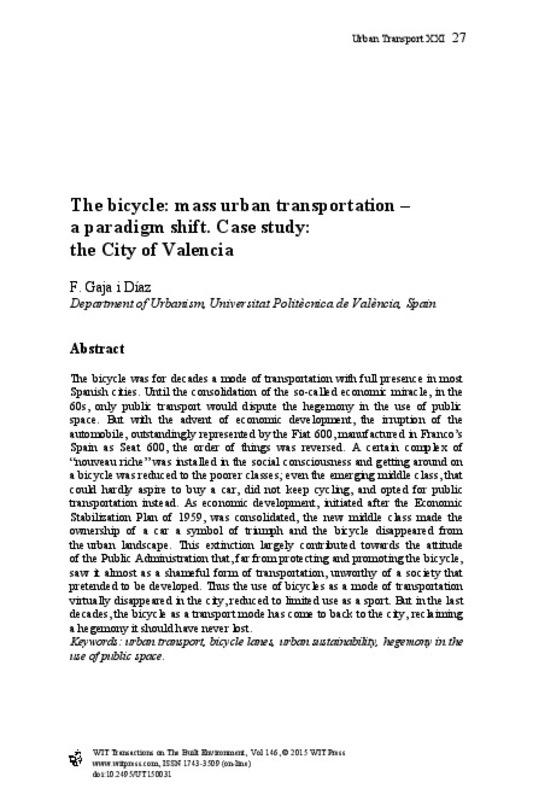JavaScript is disabled for your browser. Some features of this site may not work without it.
Buscar en RiuNet
Listar
Mi cuenta
Estadísticas
Ayuda RiuNet
Admin. UPV
The bicycle: mass urban transportation a paradigm shift. Case study: the City of Valencia
Mostrar el registro sencillo del ítem
Ficheros en el ítem
| dc.contributor.author | Gaja Díaz, Fernando
|
es_ES |
| dc.date.accessioned | 2018-06-03T04:27:42Z | |
| dc.date.available | 2018-06-03T04:27:42Z | |
| dc.date.issued | 2015 | es_ES |
| dc.identifier.uri | http://hdl.handle.net/10251/103268 | |
| dc.description.abstract | [EN] The bicycle was for decades a mode of transportation with full presence in most Spanish cities. Until the consolidation of the so-called economic miracle, in the 60s, only public transports would dispute the hegemony in the use of public space. But with the advent of economic development the irruption of the automobile, outstandingly represented by the Fiat 600, manufactured in Franco s Spain as Seat 600, that order of things was reversed. A certain complex of "nouveau riche" was installed in the social consciousness and getting around on a bicycle was reduced to the poorer classes; even the emerging middle class, that could hardly aspire to buy a car, did not kept cycling, and opted for public transportation instead. As economic development, initiated after the Economic Stabilization Plan of 1959, got consolidated, the new middle class made the ownership of a car a symbol of triumph and the bicycle disappeared from the urban landscape. To this extinction largely contributed the attitude of the Public Administration that far from protecting and promoting it, saw it almost as a shameful transportation, unworthy of a society that pretended to be developed. Thus the use of bicycles as a mode of transportation virtually disappeared in the city, reduced to a limited use as a sport. But in the last decades bicycle as a transport mode has come to back to the city, reclaiming a hegemony that should have never lost. | es_ES |
| dc.language | Inglés | es_ES |
| dc.publisher | WIT Press | es_ES |
| dc.relation.ispartof | WIT Transactions on the Built Environment (Online) | es_ES |
| dc.rights | Reserva de todos los derechos | es_ES |
| dc.subject | Urban transport | es_ES |
| dc.subject | Bicycle lanes | es_ES |
| dc.subject | Urban sustainability | es_ES |
| dc.subject | Hegemony in the use of public space | es_ES |
| dc.subject.classification | URBANISTICA Y ORDENACION DEL TERRITORIO | es_ES |
| dc.title | The bicycle: mass urban transportation a paradigm shift. Case study: the City of Valencia | es_ES |
| dc.type | Artículo | es_ES |
| dc.identifier.doi | 10.2495/UT150031 | es_ES |
| dc.rights.accessRights | Abierto | es_ES |
| dc.contributor.affiliation | Universitat Politècnica de València. Departamento de Urbanismo - Departament d'Urbanisme | es_ES |
| dc.description.bibliographicCitation | Gaja Díaz, F. (2015). The bicycle: mass urban transportation a paradigm shift. Case study: the City of Valencia. WIT Transactions on the Built Environment (Online). 146:27-37. doi:10.2495/UT150031 | es_ES |
| dc.description.accrualMethod | S | es_ES |
| dc.relation.publisherversion | http://dx.doi.org/10.2495/UT150031 | es_ES |
| dc.description.upvformatpinicio | 27 | es_ES |
| dc.description.upvformatpfin | 37 | es_ES |
| dc.type.version | info:eu-repo/semantics/publishedVersion | es_ES |
| dc.description.volume | 146 | es_ES |
| dc.identifier.eissn | 1743-3509 | es_ES |
| dc.relation.pasarela | S\309665 | es_ES |








